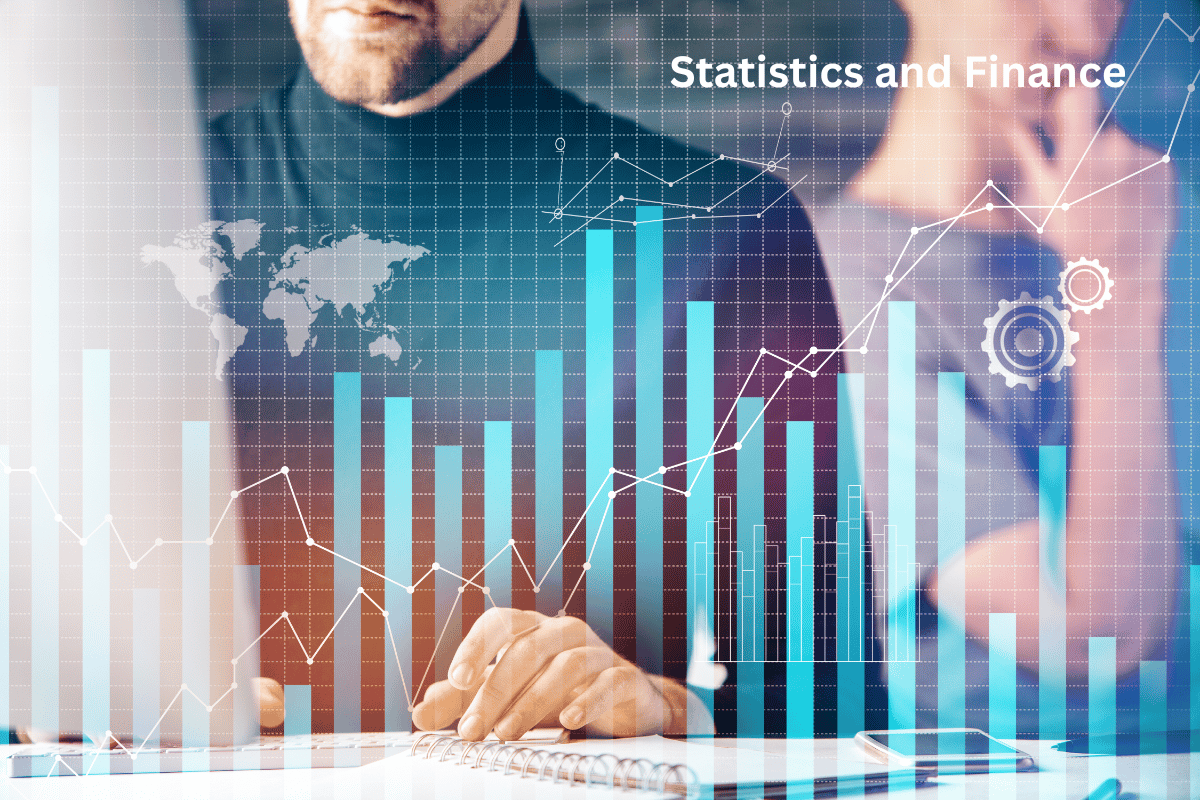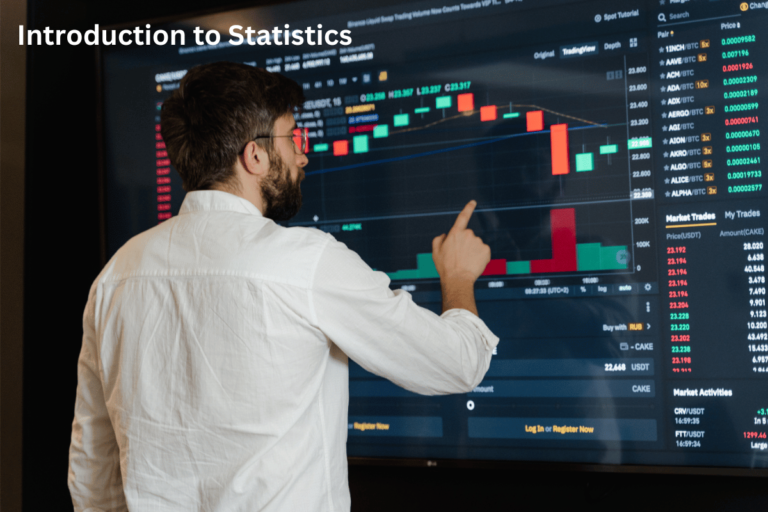Statistics and Finance: A Quick Guide
Did you know over 75% of finance leaders use metrics for big decisions? In the complex world of finance, tools like statistical finance and data-driven finance are key. The R Finance Conference, starting in 2009, has been a big deal for over 10 years. It brings together experts and fans to talk about how statistics and finance connect. The focus on R programming in finance means attendees get to dive deep into learning.
In 2022, big names like Matthew Dixon, Veronika Rockova, and Thomas P. Harte shared their knowledge. They talked about new ways in quantitative modeling and risk management. The conference is known for its hands-on workshops. These give people the skills to use R in financial analysis. Plus, there are chances to meet others in the field and check out the latest in financial tech.
Key Takeaways
- The R Finance Conference has been shaping financial tech for over a decade since 2009.
- Its single-track setup means everyone gets to fully take in the info.
- Big names like Matthew Dixon, Veronika Rockova, and Thomas P. Harte spoke in 2022.
- Workshops offer real-world R skills for financial analysis.
- Networking lets pros and peers share ideas and make connections.
- The exhibition highlights the newest in financial tech and tools.
- Now, over 75% of finance leaders rely on metrics for making big choices.
Introduction to Statistics in Finance
Finance statistics are key in the finance world. They help make smart, data-based investment choices. By using statistical analysis, experts can understand complex data, spot trends, and plan to reduce risks and increase investment gains. Knowing these statistical tools well is vital for financial success.
Importance of Statistics
Statistics give a clear way to understand financial data. This helps investors make better choices. For example, finding the mean return on investment shows how well a portfolio is doing. A mean return of 4% over five quarters shows good performance.
Other methods like the geometric mean or median return give different views on how well a portfolio is doing. The geometric mean shows a 3.72% return, and the median return is 8% for the same portfolio.
Key Statistical Methods
Many statistical methods are key in finance analysis. Each one gives unique insights:
- Regression Analysis: This method models the link between variables, important for predicting the future.
- Time-Series Analysis: It’s used to study stock prices and returns over time, helping predict future performance.
- Weighted Average Return: This method looks at the value of each asset in a portfolio, like a 7.4% return for a specific portfolio.
- Relative and Cumulative Frequency: These methods show how returns are spread out, often shown in histograms.
Using these methods helps understand market trends, improve portfolios, and create strong investment plans. The book “Statistics and Finance: Unlocking Financial Insights” by Chapman & Hall is a great resource. It’s 280 pages long and covers these important topics in detail, helping both new and experienced financial analysts.
The Role of Data Analysis in Finance
In today’s world, data is a key asset. Understanding financial data and analyzing market trends and consumer behavior is crucial. Data analytics changes the finance world by cutting down on errors in financial tasks. It helps finance teams grasp important performance indicators like revenue and net income.
Understanding Financial Data
Financial data analysis is a must for businesses today. It shapes decisions. Finance data analysts work with CFOs to make sense of data, helping with planning and forecasting finances. Sadly, only 0.5% of businesses use their data well, showing a big chance for better financial insights.
In tough times, like the COVID-19 pandemic, data analytics is key for finance to handle challenges. Big data has made the stock market better, helping with investment decisions and risk management. For example, data analytics spotted more fraud in 2020.
Tools for Data Analysis
Tools for analyzing financial data range from simple spreadsheets to complex software like Power BI and Tableau. These tools help pull out useful insights from big datasets and improve reporting in real-time. They help finance institutions manage risks and offer personalized customer experiences.
| Tool | Function | Key Benefit |
|---|---|---|
| Spreadsheets | Basic data management | Accessibility and ease of use |
| Power BI | Advanced data modeling and visualization | Interactive dashboards |
| Tableau | Comprehensive data analysis | Powerful data visualization |
Tools for finance analysis aren’t just about software; skills and training matter too. Entry-level jobs need a bachelor’s degree in a quantitative field. Senior roles require a financial background and expertise in common tools and software. Certifications like the CFA® Program boost skills in investment analysis and portfolio management, meeting the growing demand for finance pros.
As tech and financial data analysis evolve, the need for skilled analysts increases. This shows how important it is to blend analytical tools with traditional finance for a competitive edge.
Financial Modeling: The Backbone of Financial Forecasting
Creating strong financial models is key for precise financial forecasting. These models use data like expected earnings, spending, and cash flow for 12 to 36 months. They are vital for predicting financial outcomes and helping with strategic choices.
Building Financial Models
Starting to build financial models means making realistic guesses about earnings and costs. A startup’s financial model includes things like income statements, balance sheets, and cash flow statements. These statements help predict profits, track cash, and show the company’s financial health.
- Projected Revenues: Guessing future sales by analyzing data and market size.
- Expense Forecasting: Guessing costs, both fixed and variable, based on current and future needs.
- Cash Flow Analysis: Keeping an eye on cash to make sure there’s enough for operations.
- Workforce Planning: Matching payroll and staff with growth plans.
It’s important to regularly update and check financial models, like doing health check-ups. Avoiding overly positive forecasts, ignoring market trends, and not updating often are big mistakes in predictive finance.
Applications of Financial Models
Financial models are used a lot, especially in managing risks, planning strategies, and drawing in investors. Startups use them to predict their financial health and future, making better decisions. By using stats and historical data, these models get more accurate.
These models spot challenges and chances, helping startups use resources wisely. They help navigate the ups and downs of growing a business and changing markets. In fact, 80% of startups with a solid financial plan are more likely to get funding. So, financial modeling is key for seeing future financials, showing growth, and proving profitability to others.
Quantitative Analysis in Financial Markets
Quantitative financial analysis uses math and stats to make big decisions in financial markets. It turns financial info into numbers. This helps in checking out financial items and guessing big events like GDP changes.
Techniques and Methods
Quantitative analysis has many methods to grasp financial market trends. Tools like regression analysis, time series analysis, and Monte Carlo simulations are key. Regression analysis predicts outcomes from past data, helping many professionals. Algorithmic trading uses stats to spot good trading chances and trade fast.
Other methods include:
- Value-at-Risk (VaR) models, which look at the risk of investment portfolios.
- Scenario analysis and stress testing, used by central banks to check financial stability in different situations.
- Modern Portfolio Theory (MPT), which helps balance risk and return in investments.
Real-world Applications
Quantitative analysis is used in many financial areas. It helps in algorithmic trading, managing hedge funds, and in investment banking. Central banks use it to keep the economy stable. Risk modeling and derivatives pricing are key in understanding financial risks and keeping the market efficient.
Quantitative financial analysis helps reduce risks in uncertain situations. It helps in managing projects, allocating resources, and making marketing decisions. By using these methods, businesses can predict trends, use resources well, and manage projects better.
| Area | Application |
|---|---|
| Central Banking | Scenario Analysis and Stress Testing |
| Algorithmic Trading | Automated Trade Execution |
| Hedge Fund Management | Risk Modeling and Portfolio Optimization |
| Investment Banking | Derivatives Pricing |
| Marketing | Budget Allocation Based on Data |
The Importance of Financial Statistics in Business
In today’s fast-paced finance world, business financial statistics play a huge role. They help experts make smart, data-based choices. This leads to better risk management and financial strategy optimization. By using statistical tools, companies can boost their performance metrics and achieve success.
Statistical Tools in Business
Statistical tools help businesses make sense of huge amounts of financial and market data. They spot trends, predict outcomes, and guide strategic decisions. For instance, time series analysis looks at past trends in asset prices. Regression analysis predicts how things like inflation affect stock returns. These methods are key for smart statistical decision-making.
- Time Series Analysis: Crucial for studying past trends in asset prices to build portfolios.
- Regression Analysis: Helps predict economic effects on stock returns and finds interest rate models.
- Descriptive Statistics: Offers a way to understand data structure and spot general trends.
| Statistical Tool | Application | Benefit |
|---|---|---|
| Time Series Analysis | Analyzing historical data | Building portfolios based on past trends |
| Regression Analysis | Predicting economic impacts | Accurate forecasts for stock returns |
| Descriptive Statistics | Understanding data organization | Identifying general trends |
Case Studies
Real examples show how companies use financial statistics to improve. For example, Amazon has boosted its performance metrics over time. In 2023, its profit margin was 3.7%. By 2024, it jumped to 10.7%, thanks to smart use of statistical decision-making.
- Amazon: Used statistical tools to raise operating profit margin from 3.7% in 2023 to 10.7% in 2024.
- Net Present Value (NPV) and Internal Rate of Return (IRR): Used for analyzing investments and making strategic choices.
These case studies show that using business financial statistics wisely can greatly improve a company’s financial health and strategy.
Business Forecasting with Statistical Methods
Business forecasting uses statistical methods to predict future trends and outcomes. This is key for making smart decisions and planning ahead. It affects many areas in a company.
Types of Business Forecasting
There are many ways to forecast business, each with its own statistical models. The main methods are:
- Time Series Analysis: This uses past data to guess future trends. It’s great for predicting sales or stock prices.
- Regression Analysis: This method looks at how different things are connected. It’s useful for understanding financial trends and planning budgets.
- Econometric Models: These models study economic variables to help with long-term financial planning and policy making.
- Moving Average: This technique helps smooth out data to give better future predictions.
- Multiple Linear Regression: This looks at how many variables affect each other, giving deep insights for forecasting.
Benefits of Forecasting
Forecasting has many benefits, including:
- Informed Resource Allocation: It helps use resources wisely by predicting future needs and trends.
- Improved Strategic Planning: Companies can make better strategies with accurate financial trend analysis.
- Competitive Advantage: Being good at statistical forecasting lets companies quickly adapt to market changes and stay ahead.
- Risk Management: Forecasting helps spot potential risks and plan to avoid them.
Even with its benefits, forecasting has its challenges. It depends on accurate past data and models, but unexpected events and market changes can still pose problems. Still, getting good at these methods can greatly improve a company’s ability to plan and succeed in a changing business world.
Statistics and Finance: Key Concepts and Integration
Combining statistical finance with finance helps in making better decisions and planning for the future. By using key statistical ideas, finance experts can understand complex data better. This makes their financial analysis deeper.
This process includes important parts like combining financial data and using analytics in finance.
Financial institutions and experts use statistical finance for deep analysis. For instance:
- Over a thousand extra CFA questions are given by Kaplan Schweser for the CFA exams.
- Connect’s Prep Courses cover basic topics in Math, Statistics, Accounting, Excel, and Economics.
- Tableau Dashboard Activities have auto-graded questions that test execution and thinking.
- Personal Financial Plans in Connect use fake data to connect with text sections and apply theory to real-life situations.
Statistics are key in financial and business integration. For example, combining financial data starts with basic ideas and moves to more complex levels. This ensures financial analytics are vital for business success.
| Financial Indicator | Change (%) |
|---|---|
| GDP Growth in Xiajin County (H1 2020) | 0.6 |
| Industrial Output Value Reduction | -1.5 |
| Finance Deposit Balance Drop | -3.87 |
| Insurance Business Income Increase | 1.9 |
| Fixed Assets Investment Decline | -10.45 |
| Retail Sales Growth | 1.64 |
| Electricity Consumption Rise | 4.86 |
| Total Profit Increase | 11.89 |
| Finance Revenue Expenditure Reduction | -8.56 |
Analytics in finance is crucial. Tools like relative index, absolute index, and statistical grouping help in audits and decisions. These methods make financial records accurate and help combine financial and business activities.
The link between statistics and finance is vital. Finance professionals need to be good at communicating and working together. This ensures they can handle financial data well, making statistical finance key to their plans.
Probability Theory in Investment Strategies
Probability theory is key in finance. It helps us understand risks and potential returns on investments. By figuring out the chances of different outcomes, investors can make smart choices.
Understanding Probability in Finance
In finance, probability theory is a big help in looking at risk. It covers important ideas like:
- Probability Distributions: These can be either discrete, like the chance of flipping a coin, or continuous, showing all the possible outcomes within a range.
- Expected Value: This is the average result, like the 3.5 you might get when rolling a six-sided die, which helps predict what might happen.
- Variance and Covariance: Variance shows how spread out values are around the average, and covariance tells how investments move together, helping with risk assessment.
These ideas are the core of probability theory in finance. They make investment strategies better by giving a statistical look at risk and return.
Applications in Investment
Using probability theory in investment strategy makes decisions better by applying statistical models:
- Conditional Probability: This helps figure out the chance of future events based on what happened before.
- Bayes’ Theorem: Updates predictions with new data, making risk assessment more accurate.
- Binomial Distribution: Looks at outcomes over many trials, great for predicting market events.
| Concept | Application |
|---|---|
| Value at Risk (VaR) | A popular way to estimate potential losses in a portfolio. |
| Normal Distribution | Assumes stock returns follow a normal distribution but adjusts for big returns. |
| Central Limit Theorem | Says the sum of many random variables gets closer to a normal distribution. |
These methods give valuable insights for building strong financial models, investment strategies, and detailed risk assessments. They help investors make better financial choices.
Risk Management Through Predictive Modeling
In today’s fast-changing financial world, risk management is key to keeping finances stable. Predictive modeling is changing how we handle risks. It’s expected to grow to $28.7 billion by 2027, showing the big need for better risk management tools.
Importance of Risk Management
Risk management is vital for keeping finances stable. It helps predict and lower potential losses. Banks and insurance companies use predictive modeling to manage financial risks well.
They focus on predicting supply chain activities to avoid risks and keep operations smooth.
“Predictive risk analysis takes into account past and present data to forecast future occurrences, enabling organizations to prepare for potential growth or decline.”
Cyberattacks are a big risk, pushing companies to improve their risk management. They focus on avoiding legal issues in regulated fields.
Predictive Modeling Techniques
Predictive modeling uses advanced tech like machine learning to improve predictions. It helps in managing financial risks, like predicting customer defaults and detecting fraud. By using data from different sources, companies can spot risks early and act fast.
It’s also useful outside finance, like in supply chains. It helps predict activities to keep things running smoothly and make customers happy. In finance, predictive analytics is key for managing risks, helping with risk assessments and plans.
Machine learning is making predictive modeling better, speeding up risk assessment and decision-making. It helps companies with a clear risk strategy to handle risks well. This leads to faster risk management and easier changes in the company.
In summary, using predictive modeling in risk management makes finances more stable. It also improves decision-making, efficiency, and follows rules better in different industries.
Financial Planning Using Economic Models
For any business aiming for long-term success, effective financial planning is key. By using economic modeling, companies can make strong financial strategies. These strategies help them deal with different economic situations. Financial models are important here, showing what the company might do now and in the future.
Developing Financial Plans
Creating financial plans means making detailed forecasts of income, expenses, and what the company needs in terms of money. Economic modeling helps with this by using past data and predictions to forecast financial performance. For instance, the discounted cash flow model is often used to figure out the future value of investments.
Financial models usually include:
- Assumptions and drivers
- Income statements
- Balance sheets
- Cash flow statements
- Valuations
- Sensitivity analysis
- Charts and graphs
It’s crucial to have accurate financial modeling, as mistakes can be very costly. Checking these models with outside reviews makes sure they’re reliable and correct. This makes them good tools for making strategic decisions.
Economic Models Benefits
Using economic models in financial planning has many benefits. For one, they give a full picture of what the company might earn or spend, helping with better decisions. FP&A analysts use these models to look at different scenarios and how they might affect profits. They also use sensitivity analysis to get ready for different market conditions.
Templates, like those in Excel or special software, make financial modeling more efficient. They help avoid mistakes. There are different models for different needs, like the three-statement model for planning and the merger model for showing a company’s value to others.
In short, adding economic modeling to financial planning helps businesses make strong financial strategies. It helps them deal with uncertainty and reach their financial goals.
Portfolio Management and Statistical Analysis
Portfolio management uses statistical methods to help make smart investment choices. By analyzing financial portfolios, investors can balance risk and return well. This part talks about strategies for managing portfolios and the key role of statistics in analyzing them.
Strategies for Portfolio Management
Good portfolio management means creating strategies that match the investor’s goals and how much risk they can take. Here are some common methods used:
- Active Management: This method means buying and selling assets to beat the market. Managers use statistics to find good deals and change the portfolio as needed.
- Passive Management: This approach tries to match the market’s performance, like the S&P 500. It’s cheaper and uses statistical models to keep up with the market.
- Hybrid Strategies: This mix of active and passive management offers a balanced approach. It uses the stability of passive methods and takes active chances when right.
- Mean-Variance Optimization: A key strategy, this method adjusts portfolio weights to get the most return for a set risk level.
Role of Statistics in Portfolio Analysis
Statistics play a huge part in investment, supporting all parts of financial portfolio analysis:
Models like the Capital Asset Pricing Model (CAPM) and the Efficient Frontier help evaluate asset performance and risk. Important factors like expected return (\(\mu\)), variance (\(\sigma^2\)), and covariance (\(\sigma_{ij}\)) are key to these models.
To show how statistics work in practice, look at this table. It shows the details for simple returns on two assets and their mix:
| Parameter | Asset A | Asset B | Portfolio (Equal Weights) |
|---|---|---|---|
| Mean Return (\(\mu\)) | 5% | 7% | 6% |
| Variance (\(\sigma^2\)) | 9% | 16% | 12.5% |
| Standard Deviation (\(\sigma\)) | 3% | 4% | 3.5% |
| Correlation (\(\rho\)) | 0.6 | N/A | |
This example shows how statistics help in building portfolios. By looking at mean return and variance, investors can see the trade-offs between risk and return. The correlation between assets A and B helps understand how they affect the portfolio’s risk.
In the end, good portfolio management uses strong statistics to improve decisions and get the best financial results.
Business Analytics: Driving Financial Decisions
In today’s market, using business analytics is key for making smart financial choices. A strong data strategy helps companies use financial data to grow. Business analytics includes many metrics and tools to improve financial performance.
Data-Driven Decision Making
Using data to make decisions helps finance pros make informed choices. Important metrics like Gross Profit Margin and Net Profit Margin show how profitable and efficient a company is. Metrics like Operating Expenses Ratio and Current Ratio look at cost control and cash flow.
Having real-time financial data is crucial. Tools like the Phocas Financial Statements module offer easy access to financial data. This lets finance teams quickly adapt to market changes, making the business more agile.
Implementing Business Analytics
Starting with business analytics means bringing together financial and operational data. This gives a full view of how well a company is doing. Dashboards and detailed financial statements help analyze and understand performance better.
These analytics platforms also help finance teams work together on plans. Dashboards track metrics like Return on Assets (ROA) to show how well assets are used. Advanced visuals and AI make data easier to understand and act on.
| Financial Metric | Purpose |
|---|---|
| Gross Profit Margin | Tracks profit generation per dollar of revenue |
| Operating Expenses Ratio | Compares costs of core operations to total revenue |
| Net Profit Margin | Measures how efficiently revenue turns into profits |
| Current Ratio | Measures the ability to pay short-term obligations |
| Accounts Payable Turnover Ratio | Tracks how quickly a company pays suppliers |
| Accounts Receivable Turnover Ratio | Measures how quickly a company collects payments |
By blending a strong data strategy, business and financial analytics become one. This creates insights that boost both business and financial operations. Using analytics not only spots inefficiencies but also guides better workflows and investment choices.
Applying Econometrics to Real-world Finance
Econometrics is a key part of economics that mixes economics, statistics, and math. It uses these to study economic data with mathematical models. By using econometrics in real finance, companies can make smarter choices based on data.
Overview of Econometrics
Econometrics helps predict market trends by looking at what people buy and their social and economic situations. It started in the 1930s and 1940s with regression analysis. Now, it includes newer methods like Bayesian estimation and quantile regression.
Financial Applications
In finance, econometric models are crucial. They help figure out the risks and rewards of investments, make better portfolios, and predict demand. Governments use them to check how policies will affect things, and businesses to plan their sales and production.
These models are also key in managing risks. They estimate the chances of certain events and set prices for insurance.
Applied econometrics is a big success. Its graduates become Financial Analysts, Economists, and Data Scientists. Even with more focus on abstract research, its use in real finance keeps offering real benefits. It connects theory with what actually happens in the world.
Investment Analysis and Data Interpretation
In finance, investment analysis is key to making smart choices. By using data interpretation, investors can spot good opportunities and avoid risks. This includes methods like fundamental, technical, and market analysis. Knowing these methods helps investors make wise choices.
Analyzing Investment Opportunities
Investment analysis is about looking at different chances. It means checking a company’s finances, future, and possible earnings. Famous investors like Warren Buffett and Benjamin Graham prefer looking at a company’s core details.
- Fundamental analysis looks at a company’s finances, market spot, and economic signs to find its true value.
- Technical analysis looks at price changes and signals to help with buying and selling.
- Comparative market analysis compares different investments to find the best ones.
Data Interpretation Techniques
Good data interpretation is crucial for finding financial chances. Analysts use various methods to understand data and offer advice. Ratio analysis, for example, compares a company to others or the industry, giving investors useful info. Also, analyzing financial data helps with budgeting, forecasting, and managing risks, helping businesses make smart choices.
| Technique | Description | Application |
|---|---|---|
| Fundamental Analysis | Looks at financial statements, market spot, and economic signs. | Helps find a company’s true value for long-term investments. |
| Technical Analysis | Focuses on price changes and trading signals. | Used by day traders to time their trades. |
| Ratio Analysis | Compares a company’s performance to industry standards. | Shows strengths and weaknesses in financial health. |
Using strong investment analysis and precise data interpretation helps investors find big financial chances. BlackRock’s strategy of being neutral on long-term Treasuries but overweight in stocks shows a deep understanding of risks and returns. This highlights the value of these methods in today’s changing finance world.
Fraud Detection and Prevention with Analytics
Financial fraud is a big problem for industries like banking and healthcare. It causes losses over $10 billion a year. That’s why finding ways to spot and stop fraud is key. Analytics tools are crucial for this.
Understanding Fraud in Finance
Fraud in finance means using deceit to make money. It includes things like stealing identities and insurance fraud. To catch fraud, we use both old and new methods.
- Statistical parameter calculation
- Regression analysis
- Probability distributions
- Data matching and time-series analysis
- Data mining and pattern recognition
Analytical Tools for Fraud Prevention
Advanced analytics tools are vital in fighting fraud. They use predictive and prescriptive analytics to spot and stop fraud.
| Technique | Application |
|---|---|
| Predictive Analytics | Uses past data and models to predict and catch fraud. |
| Prescriptive Analytics | Uses predictive insights to suggest how to prevent fraud. It sets alerts and suggests audits based on costs. |
Machine Learning (ML) models are key for catching fraud in real-time. They use different algorithms to find unusual patterns. Tools like HEAVY.AI help analyze big data fast, making fraud detection better.
Anomaly detection is also important. It uses stats and ML to find things that don’t fit the norm. Network analysis tools watch over digital spaces, using ML to stop fraud early.
To stay ahead of fraud, financial leaders need to use the latest tech. They should keep improving how they detect fraud. Having a strong analytics culture and multiple security layers is crucial for protecting finances.
Conclusion
Statistics and finance come together to give professionals the skills they need for deep financial analysis and smart decisions. This article showed how important data literacy is in finance. It helps manage risks, improve performance, and grow businesses in today’s financial world.
We looked at basic and advanced statistics, like regression analysis. These tools help financial analysts make accurate predictions and understand trends. They show how important both numbers and stories are in finance.
Using statistical tools helps finance experts make better decisions, manage money, and model economies. They can predict financial trends, spot fraud, or handle investment risks. Statistics in finance keeps businesses ahead and strong in a changing market. This summary highlights how crucial data literacy is for success in finance today.
FAQ
What is the R Finance Conference?
The R Finance Conference is an annual event. It brings together financial tech fans and R experts. They share new methods and network with leaders in the field. Since 2009, it’s been a top spot for using R in finance.
Why is statistics important in finance?
Statistics is key in finance for making sense of data and spotting trends. It helps predict market moves and guide investments with tools like regression and time-series analysis.
Which tools are commonly used for financial data analysis?
For financial data analysis, tools range from simple spreadsheets to advanced software like Power BI and Tableau. These tools help manage risks, spot fraud, and create personalized customer experiences.
What is the significance of financial modeling?
Financial modeling is crucial for accurate forecasts. It uses stats to predict financial outcomes. This supports strategic decisions in areas like budgeting and valuations.
How does quantitative analysis benefit financial markets?
Quantitative analysis uses math and stats to evaluate assets and guide trades. It’s behind algorithmic trading strategies that analyze big data for profitable trades.
How are statistical tools utilized in business?
Statistical tools help businesses check their performance and make smart decisions. They use these tools to improve their financial health and strategic direction.
What are the benefits of business forecasting with statistical methods?
Forecasting with stats offers better resource use, strategic planning, and a competitive edge. It predicts future trends and outcomes for businesses.
How is probability theory applied in investment strategies?
Probability theory helps assess risk and guide investment choices. It’s used in portfolio diversification and pricing options.
What role does predictive modeling play in risk management?
Predictive modeling is vital for managing risks. It uses data to develop strategies for loss prevention and mitigation.
How do economic models assist in financial planning?
Economic models simulate different scenarios. They help create strong financial plans by showing possible outcomes.
What is the importance of statistical analysis in portfolio management?
Statistical analysis is key in portfolio management. It guides investment choices and asset allocation. It helps reduce risks and improve portfolio performance.
How does business analytics drive financial decisions?
Business analytics uses financial data for better decision-making. It combines data, generates reports, and predicts outcomes for strategic growth.
What is the role of econometrics in finance?
Econometrics uses stats on economic data to test theories and forecast trends. In finance, it’s used for market analysis and policy evaluation.
What are the techniques for investment analysis?
Investment analysis involves looking at data to spot opportunities. It uses methods like market comparison and fundamental analysis, and alternative data for valuing assets.
How is analytics used in fraud detection and prevention?
Analytics finds unusual patterns for fraud detection in finance. Tools with machine learning catch fraud in real-time and prevent it.
Source Links
- Unlocking Financial Insights: Join Us at the R Finance Conference – R Consortium
- Savant’s Financial Data Analytics Software
- Basic Statistics Concepts for Finance
- A Course on Statistics for Finance
- How Is Data Analytics Used in Finance | CompTIA
- What Does a Financial Data Analyst Do?
- The Power of Financial Modeling: How It Can Benefit Your Company | Finro Financial Consulting
- Creating a Robust Financial Model: The Backbone of Your Startup
- Quantitative Analysis (QA): What It Is and How It’s Used in Finance
- Quantitative Analysis
- Statistics for Finance
- Financial Analysis: Definition, Importance, Types, and Examples
- Statistics
- Forecasting: What It Is, How It’s Used in Business and Investing
- What Is Business Forecasting? Definition, Methods, and Model
- Forecasting Methods
- Finance | McGraw Hill
- The Evolution of Business-Finance Integration
- What Investors Need to Know About the Probability Theory
- Probability Distribution: Definition, Types, and Uses in Investing
- How Predictive Analytics for Risk Management Works?
- How Predictive Analytics tranform Risk Management | 10xDS
- Financial Modeling: Definition and Uses
- 10 Types of Financial Models Every FP&A Analyst Needs To Know – Vena
- 15.1 Statistical Analysis of Portfolios: Two Assets | Introduction to Computational Finance and Financial Econometrics with R
- How to Use Data Analytics for Better Portfolio Management
- Portfolio Management: Definition, Types, and Strategies
- How can financial data analytics enhance your team’s decision-making?
- Business Analytics vs. Financial Analytics: What’s the Difference?
- Unveiling the Power of Econometrics in Daily Life: Harnessing Data for Better Decision-Making
- What is econometrics?
- Investment Analysis: Definition, Types, and Importance
- Financial Statement Analysis: What is it & how it works in 2024?
- Economic Data Interpretation: A Guide for Investors – Rosenberg Research
- What is Fraud Detection and Prevention? Definition and FAQs | HEAVY.AI
- Using fraud data analytics to detect and prevent fraud | Fraud.com
- Advanced Analytics for Fraud Detection and Prevention – Controllers Council
- Statistics: Definition, Types, and Importance
- Validity of Statistical Conclusions | Validity and Validation
- How to Write a Great Business Report Conclusion: Everything You Need to Know | Databox







